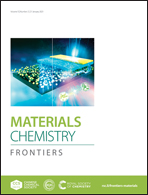Nanostructured organosilicas constructed by homopolycondensation of a transesterified bulky precursor and their potential in laser desorption/ionization†
Abstract
Covalently crosslinked organosilicas are useful for constructing optically, electronically and photochemically functional materials because of their robustness, morphological variety and tunability of the framework functionality based on the molecular design of the organic moieties. However, it has been challenging to prepare nanostructured organosilicas from 100% organosilane precursors with large organic functional moieties. In the present study, the synthesis of three types of nanostructured naphthalimide (NI)–silica hybrid materials has been achieved by hydrolysis and polycondensation of a common organosilane precursor and their photofunctional properties have been examined. The original NI-derived precursor having triisopropoxysilyl groups is highly hydrophobic and unsuitable for the preparation of nanostructured materials in aqueous media. Transesterification of the triisopropoxysilyl groups with 2-methoxyethanol or diethylene glycol monomethyl ether drastically changes the dispersibility and solubility of the NI-derived precursor in water, which enables the generation of nanospheres, microparticles with a wrinkled surface and periodic mesoporous organosilicas from the bulky NI derivative alone. The NI–silica hybrid particles that can efficiently absorb UV light can function as analytical substrates for laser desorption/ionization mass spectrometry (LDI-MS). The nanostructures of the NI–silica particles have significant effects on the LDI performance and their structure–property relationships are discussed.



 Please wait while we load your content...
Please wait while we load your content...